Quick Answer
Website monitoring tools are special software programs that keep an eye on a website's uptime, performance, user experience, and functionality in real time. These digital protectors keep your website from going down for long periods of time, find problems with the user experience, and make sure that it works well on all devices and in all locations. From simple uptime monitors like Uptime Robot to full-fledged platforms like Zipy.ai, the right website monitoring tool can make a big difference in how reliable and satisfying a site is for users.
What do systems do in digital apps?
In today's tech world, systems are the building blocks of all digital applications. These basic frameworks have a direct effect on how good the user experience is and how reliable the application is. Well-tuned systems make digital platforms run smoothly, just like a tuned engine makes a car run better.
For modern digital apps to work smoothly, they need a strong system architecture. Problems with the performance of core systems spread through all application ecosystems, lowering user satisfaction and hurting business results.
How do tools for monitoring performance keep systems healthy?
Tools for monitoring performance act as quiet protectors of the health of system infrastructure. These specialized solutions keep an eye on applications all the time and stop small problems from turning into big system failures. Digital monitoring systems cut down on expensive downtime and make better use of resources.
Important ways to protect are:
- Constantly checking on the health of the system
- Finding and fixing problems early on
- Making the best use of resources and giving them out
- Keeping the user experience consistent
Tools for monitoring performance are like preventive medicine for digital infrastructure. They find possible bottlenecks before users notice that performance is getting worse.
What are tools for monitoring API performance?
The main goal of API performance monitoring tools is to make sure that application programming interfaces are as fast and reliable as possible. These specialized platforms give API ecosystems real-time information and tools to improve performance. They keep the API working well no matter how much traffic or how people use it.
APIs link up modern business services, apps, and data sources in digital ecosystems. API failures can cause system-wide outages and service disruptions if they aren't properly monitored. Monitoring APIs well stops cascading failures in digital systems that are connected to each other.
Main functions of API monitoring:
- Keeping track of how well the interface works
- Improving request-response time
- Guaranteeing reliability under load
- Monitoring the health of the integration
This optimized section keeps the depth of your original content while changing its structure to make it easier for AI to read and more interesting for users. Each chunk has a clear heading and a short explanation of less than 100 words that focuses on one idea.
What are the best tools for keeping an eye on websites in 2024?
To keep an eye on modern websites, you need special tools that let you see everything and fix problems. These platforms help businesses keep their users happy by constantly tracking performance and fixing problems. The following tools are some of the best options for different monitoring needs and business needs.
Zipy: A full platform for monitoring websites and user experiences

Best for: Teams that want to analyze user sessions in depth, debug problems in advanced ways, and use AI to fix errors.
Zipy lets you keep an eye on your digital experience by letting you replay user sessions, track errors, and use debugging tools. This platform helps find problems with the user experience while also raising conversion rates and retention rates. Zipy's integrated monitoring ecosystem makes it easy for marketing, product, and engineering teams to work together.
"Zipy has changed my life in ways I can't tell you! Between 2 projects, I have found bugs that would have taken developers years of debugging." - Connolly, Co-founder & CTO at DirectNorth Digital
Main Features of Zipy
Main Features Are:
- Tracking user events like clicks, scrolls, and navigation patterns
- Setting up custom alerts for important notifications
- Filtering and dividing users for more focused analysis
- Performance dashboards that show URL and error type information
- Full session context with information about the user's environment
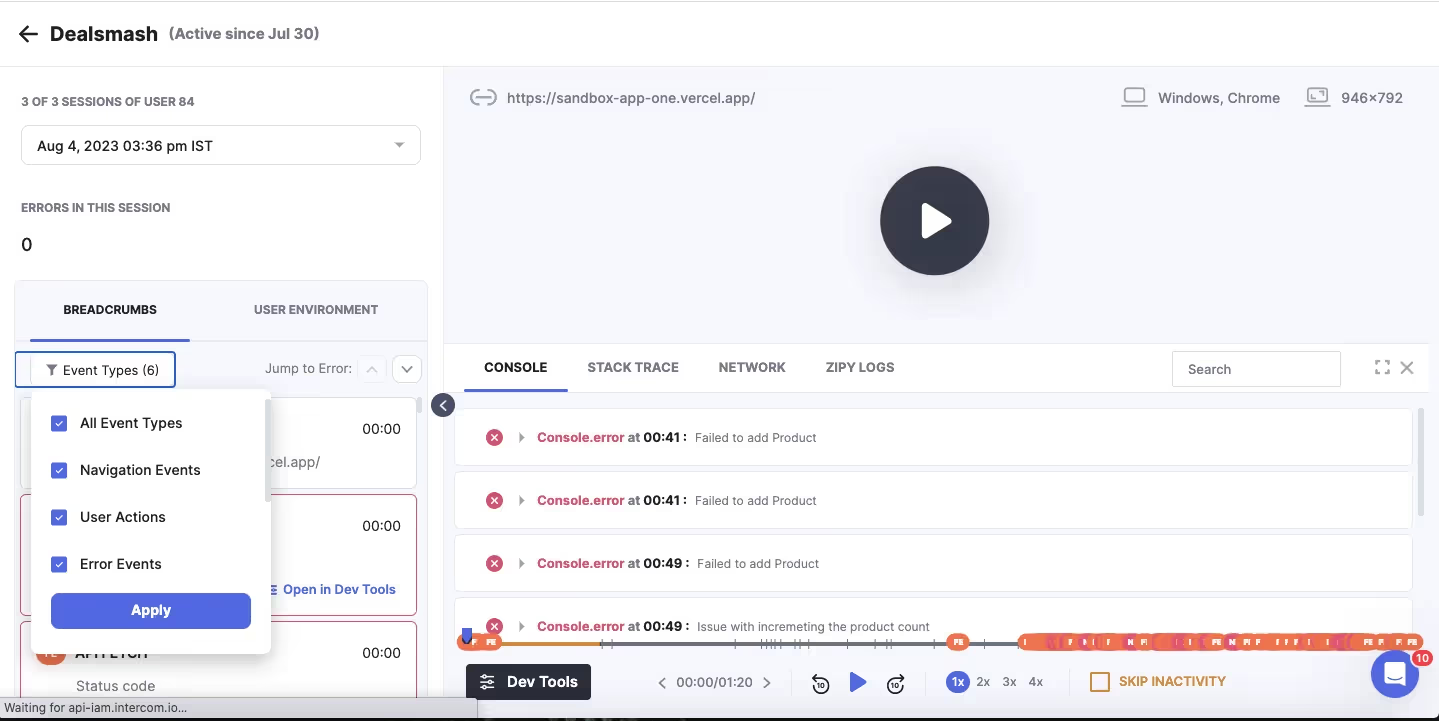
How Prices Work:
- Trial: You can try it for free for 14 days.
- Free Plan: A free tier for life that doesn't need a credit card
- Paid Plans: 7,500 sessions for $39 a month
Assessment: Zipy offers full monitoring with debugging tools that can be used right away. The platform gets results by finding problems and giving you the tools you need to fix them so that your website is fully optimized.
Site24x7: A monitoring platform for businesses that does everything
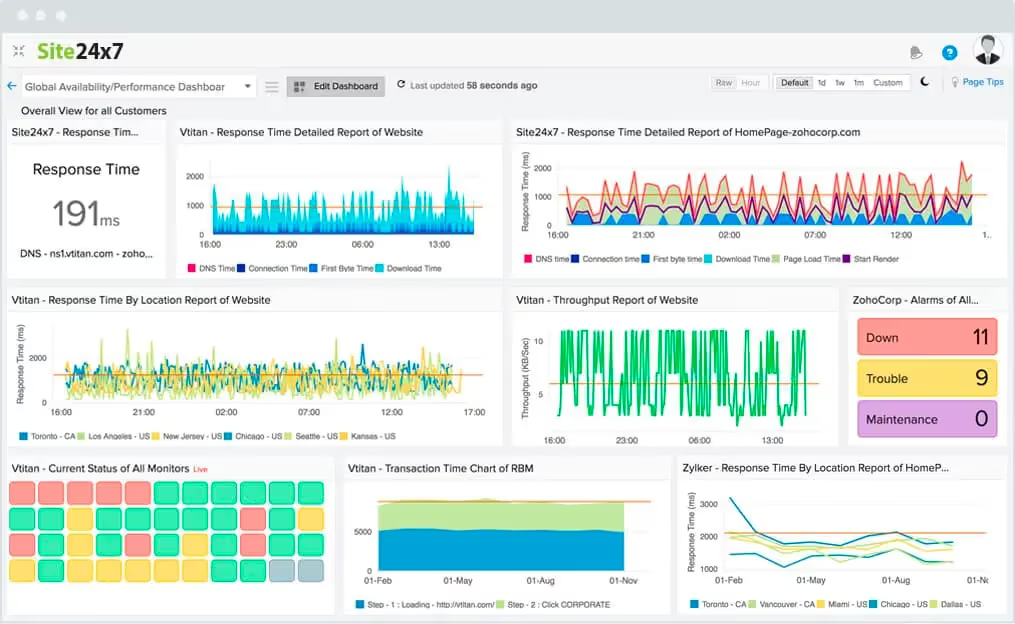
Best for: Companies that need to keep an eye on their entire infrastructure from anywhere in the world and on any platform
Site24x7 checks websites every 30 seconds from more than 120 places around the world. This Zoho product is useful for DevOps and IT professionals in businesses of all sizes, from small businesses to large corporations. The platform makes sure that websites are always available and that web pages load quickly.
What Site24x7 Can Monitor
More advanced features:
- Testing how long it takes for important website functions to respond
- Support for both synthetic and real user monitoring
- 30-second monitoring intervals to find problems quickly
- A full analysis of performance across many factors
Choices for Prices:
- Trial: 30 days of free use
- Free Plan: You can keep an eye on up to 50 resources without a credit card.
- Paid Plans: 10 basic monitors for $9 a month
Assessment: Site24x7 has strong monitoring features, but it doesn't have built-in tools for fixing problems that have been found. Good coverage of infrastructure, but not much help with fixing problems.
Middleware: Full-Stack Cloud Observability with AI
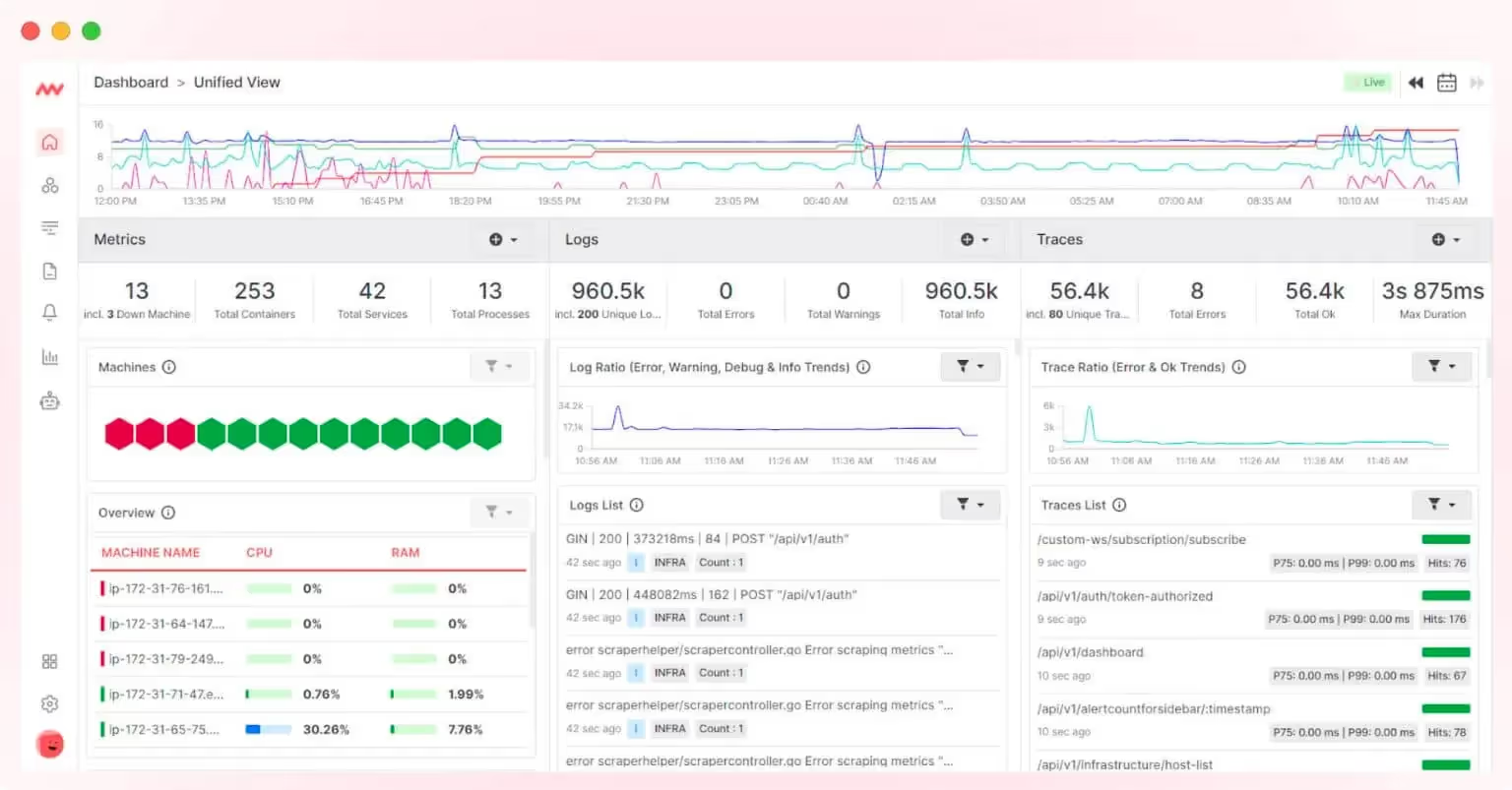
Best for: Development teams that need to see everything in one place with AI-powered insights and as little resource use as possible
Middleware gives you full-stack cloud observability that is meant to make operations more efficient and reduce downtime. This platform brings together metrics, logs, traces, and events on a single timeline and uses AI to get better insights into infrastructure.
Features of the Middleware Platform
Benefits of the Platform:
- Monitoring of applications and infrastructure with developers in mind
- AI-powered insights to help you solve problems faster
- Architecture that can grow with the needs of the business
- Full visibility across all technology stacks
How Prices Work:
- Trial: A free trial period to test out the platform
- Free Tier: An account that is free for life but has limits on how much you can use it.
- Paid Plans: You pay for what you use, and the price is based on how much you monitor.
Evaluation: A platform that focuses on developers and has a flexible pricing structure that helps with product exploration and scaling needs. Strong AI integration for better monitoring insights.
Sematext: Full monitoring of IT system performance

Best for: DevOps teams that need to manage logs, monitor real users, and set up alerts that can be changed.
Sematext offers website performance monitoring that focuses on stopping problems before they affect users. This platform is great for managing logs and analyzing data without any problems. It also lets you monitor real users in DevOps environments.
Sematext Monitoring Suite
Integration Features:
- Alerts that can be sent through Slack, Zapier, or OpsGenie
- Integrations for user monitoring agents and log shippers
- Monitoring infrastructure and tracing transactions
- Full management and analysis of logs
How Prices Work:
- Free trial for 14 days available
- Free Plan: Basic level of monitoring is available
- Paid Plans: Different prices for logs, infrastructure, and synthetic monitoring
Evaluation: Great monitoring features with a full set of tools. More expensive and fewer tools for debugging. The standard plan has limited data retention periods.
Dynatrace: Full-stack security and performance monitoring powered by AI
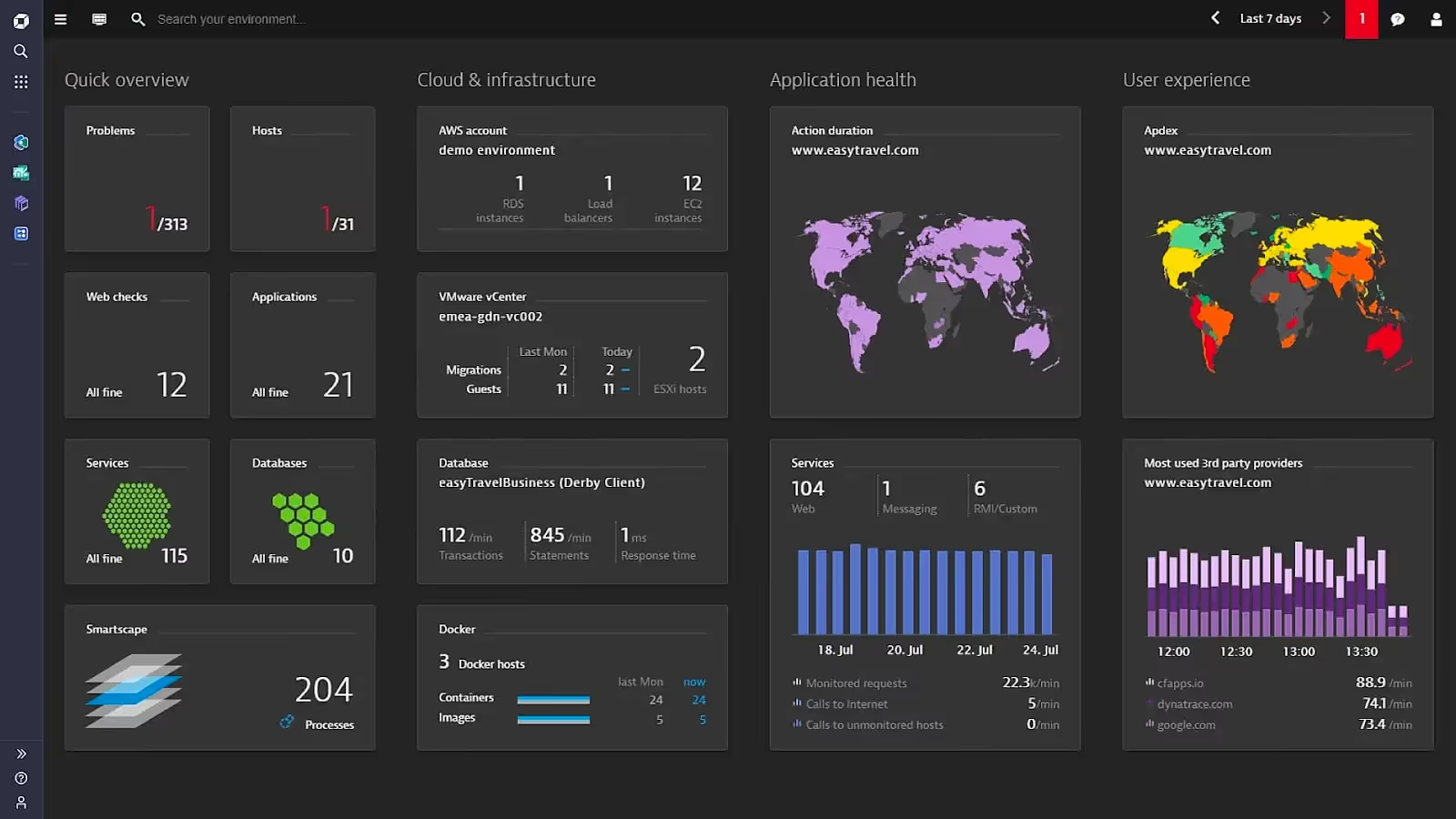
Best for: Big companies that need automated problem solving, full-stack observability, and AI-powered root cause analysis
Dynatrace finds and fixes performance problems in real time, before they affect customers. This platform lets you see everything from the frontend to the backend, the cloud infrastructure, and the application layers. AI-powered analytics provide automated pipeline delivery and operational automation across complex ecosystems.
The platform's business analytics link performance metrics for end users directly to measurements of how much money they make. AI processing takes care of billions of ecosystem dependencies to make performance as good as it can be.
More Advanced Features of Dynatrace
Main Features of AI:
- Automatically finding microservices in dynamic container environments
- Billions of processing dependencies for automating ecosystems
- Finding the root cause of performance problems
- Keeping track of the whole customer journey from the front end to the back end
How Prices Work:
- Trial: You can try it out for free for 15 days.
- Free Plan: There is no free tier.
- Paid Plans: Prices based on use, with help from the sales team
Assessment: Needs a lot of learning, especially for people who are new to observability. High prices make it hard for small businesses to use it. Strong enterprise-level features with full AI integration.
Datadog: A full platform for website security and performance
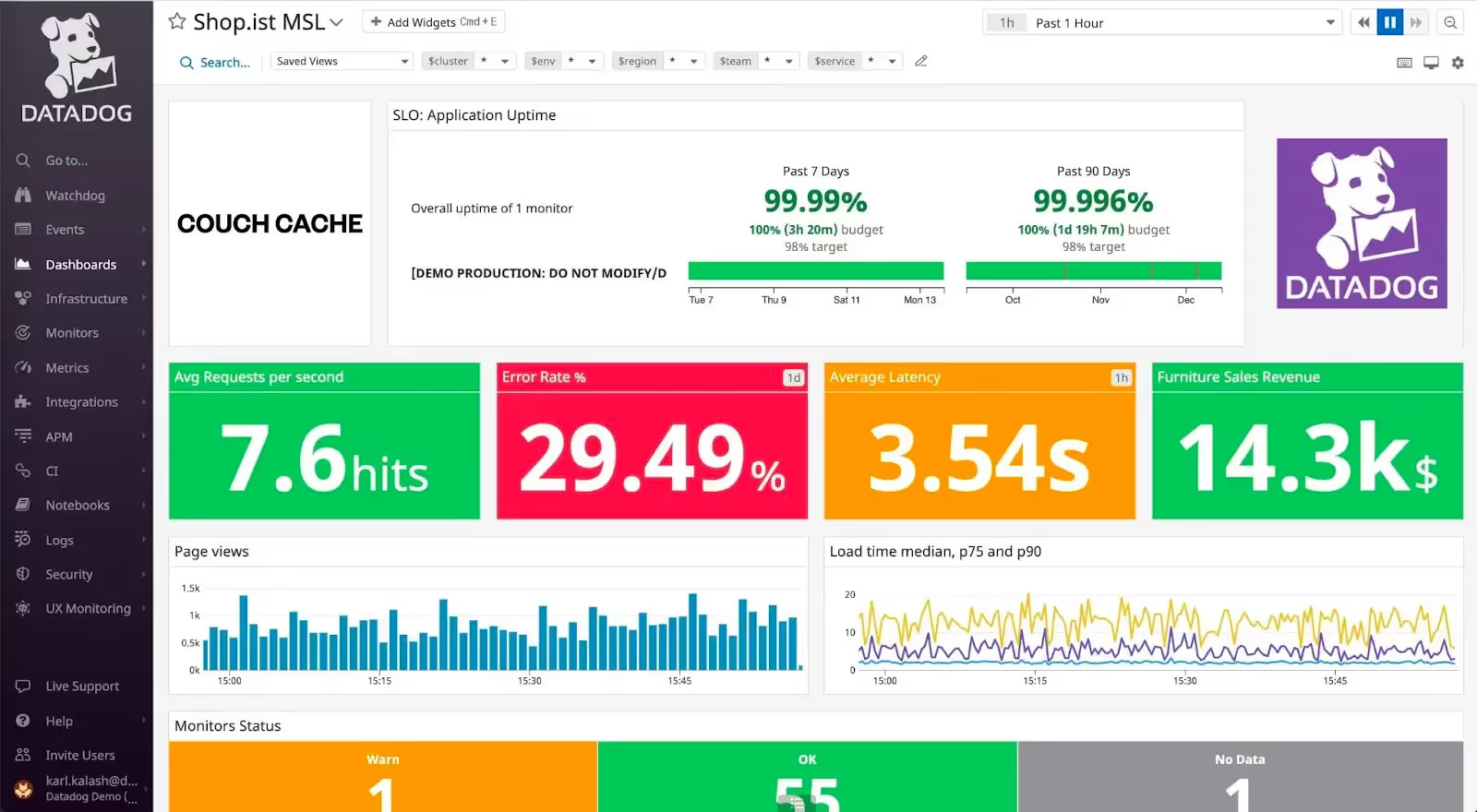
Best for: Businesses that need to monitor real users, do synthetic testing, and get a full picture of how well their front end is working.
Datadog lets you keep an eye on your digital experience with real user monitoring and synthetic monitoring. The platform runs browser tests and API calls to find problems that users might have while simulating transactions. Root cause analysis finds problems in the code, infrastructure, and network layers.
Synthetic monitoring lets you test everything at all stages of development and in different environments. Frontend performance visualization covers a wide range of countries, devices, and apps to give you detailed information about how users are experiencing your site.
Features of Datadog Monitoring
Advanced Analytics:
- Showing frontend performance metrics by device and location
- Grouping errors to find out what they mean and cut down on noise
- Monitoring each user's session and reproducing bugs
- The ability to do synthetic testing across different environments
How Much Does It Cost?
- Trial: 14 days of free use
- Free Plan: Some features are missing, like monitoring and log management.
- Paid Plans: All solutions have usage-based pricing
Evaluation: Strong application performance monitoring with full bug tracking. Prices are higher than those of competitors. New users need to get used to the platform before they can use it.
Pingdom: A simpler way to check how well a website is working and how often it is down.
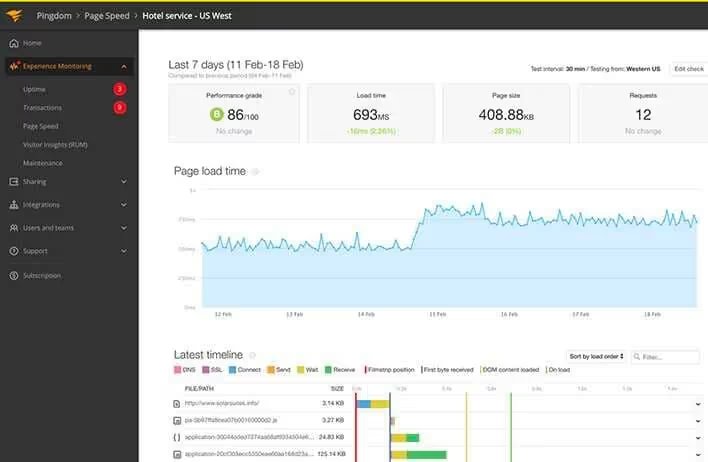
Best for: Teams that want a simple way to set up monitoring that is easy for both technical and non-technical people to use
Pingdom uses cloud-based infrastructure to keep an eye on how well a website works, how often it goes down, how users interact with it, and how they behave. The platform is easy to set up and has user-friendly interfaces that work for people with a wide range of professional backgrounds. Real user monitoring, synthetic monitoring, and infrastructure oversight all work together.
Dashboard reporting includes detailed analytics and the ability to create custom email reports to check page speed and uptime. You can manage your status on the go with mobile apps.
Pingdom's main features are:
Monitoring Capabilities:
- Page viewing analytics and real-time data on user behavior
- Tracking time spent on a page with a lot of filtering options
- Finding performance problems with access to the right log data
- Automatic failure detection for critical site flow monitoring
**How Prices Work:
- Trial: You can try it for free for 30 days.
- Free Plan: There isn't a free tier.
- Paid Plans: Starting at $10 a month with yearly billing
Assessment: Other companies offer similar monitoring features for less money. You have to pay extra for SMS alerts. Doesn't have tools for debugging or the ability to replay sessions.
New Relic: Full-Stack Observability with AI-Assisted Debugging

Best for: Development teams that need to keep an eye on the whole stack and get help with debugging and Google Core Web Vitals integration.
New Relic is an observability platform that lets you watch over, fix, and improve whole technology stacks. The platform speeds up the process of finding problems with mobile apps, web apps, and websites, and it also prioritizes the most important ones through root cause analysis. Error tracking, change tracking, and network monitoring are all parts of application monitoring.
The GenAI assistant "Grok" automatically finds code-level errors and suggests fixes based on production telemetry and stack traces. Google Core Web Vitals are part of dashboard integration for analyzing page performance.
Parts of the New Relic Platform :
Features that Use AI:
- Grok GenAI assistant for finding code-level errors automatically
- Analyzing production telemetry with code snippets added
- Looking at the stack trace and giving automated fix suggestions
- A curated log display to help you find problems faster
Choices for Prices:
- Free Plan: Includes 100 GB of data ingestion per month
- Paid Plans: Prices are based on how much you use them.
Evaluation: A mature platform with great customer service features. Limits on data usage, with extra fees for using more data. Full set of features, but costs may go up based on how much data is used.
Uptime Robot: A Must-Have Tool for Monitoring Website Availability
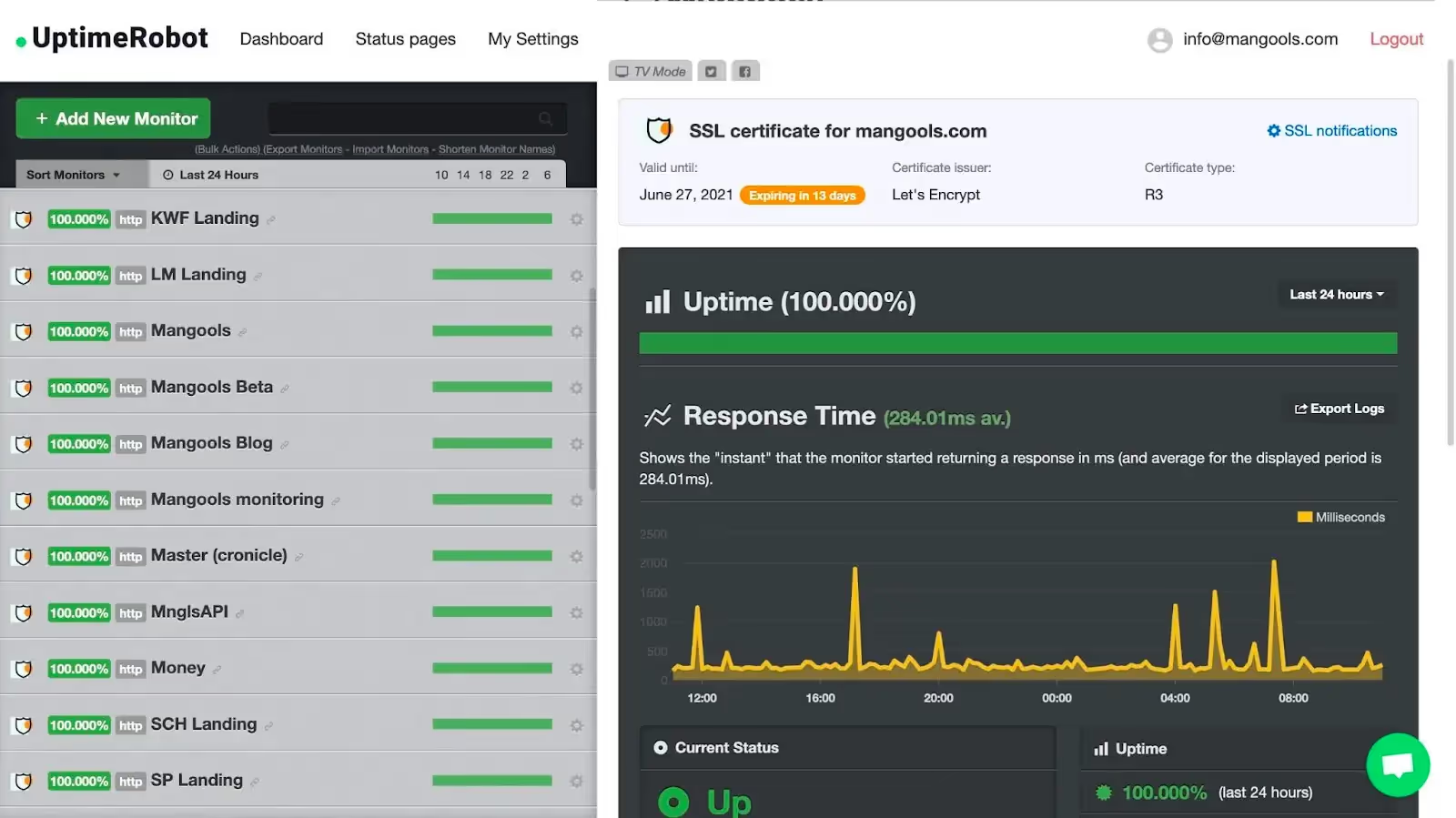
Best for: Small businesses that need basic uptime monitoring with the ability to get alerts right away and not too much setup work.
Uptime Robot checks the availability of websites every minute and sends out alerts right away when there is an outage. The platform keeps an eye on servers, SSL certificates, and domain name expiration and sends alerts through voice calls, email, SMS, and integrations with Slack and Zapier.
With mobile app support, busy professionals who need to keep an eye on website availability can do so while they're on the go.
Features of Uptime Robot Monitoring :
Setting Up Alerts:
- Settings for the recurrence parameter to stop serious outages
- Customizing thresholds for managing alerts more effectively
- Different ways to get notifications, like voice, email, and SMS
- Help with integrating with well-known collaboration tools
**How Prices Work:
- Trial: There is no free trial available
- Free Plan: 50 monitors come with it
- Paid Plans: $7 a month, billed once a year
Assessment: Good for making sure that a website is accessible, but it doesn't check for errors or look at how users behave. There are no debugging tools, which is a big problem for full monitoring needs.
Uptrends: Keep an eye on how well websites are doing around the world and track transactions
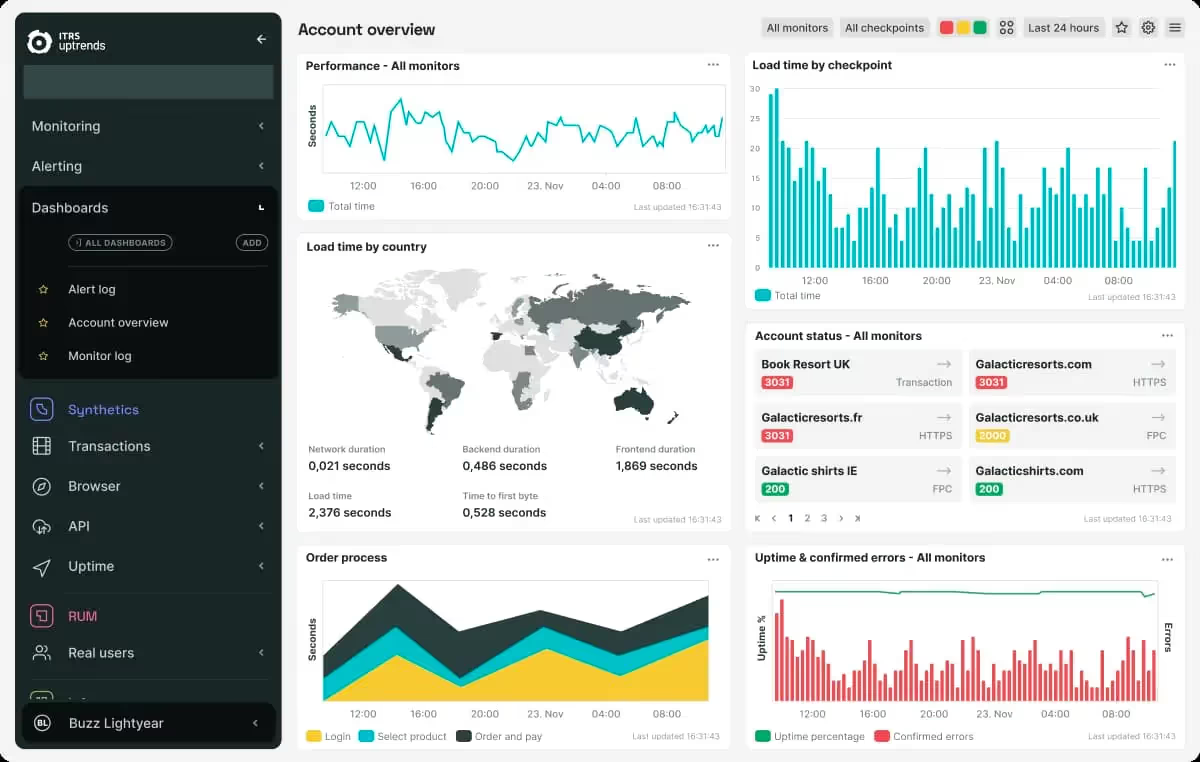
Best for: Businesses that need global monitoring with transaction verification and cloud cost optimization features
Uptrends uses 233 global checkpoints to combine synthetic monitoring, real user monitoring (RUM), and server monitoring. The platform keeps track of how long a website is up and running and how well it works. It also supports continuous monitoring of availability, performance, and transactions. Cloud cost management includes a thorough look at ways to improve costs.
Transaction monitoring checks important web application processes like logging in, signing up, using the cart, and completing payments for important business operations.
All the features of Uptrends :
Features for Monitoring Transactions:
- Check the process for logging in and signing up
- Keeping an eye on the shopping cart and payments for e-commerce
- Keeping track of important business processes
- Making sure that web applications work as they should
- Continuous oversight of vital operations
Model for Pricing:
- Trial: All plans come with a 30-day free trial.
- Free Plan: There is no free tier after the trial period.
- Paid Plans: The starter plan costs $17.50 per month for 10 monitors.
Assessment: It has good features for recording transactions, which makes it good for mapping out the customer journey. There is a free version with limited features, and the price goes up for extra features. A wide checkpoint network gives you full global coverage.
LogRocket: Advanced Session Replay with Product Analytics Built-In
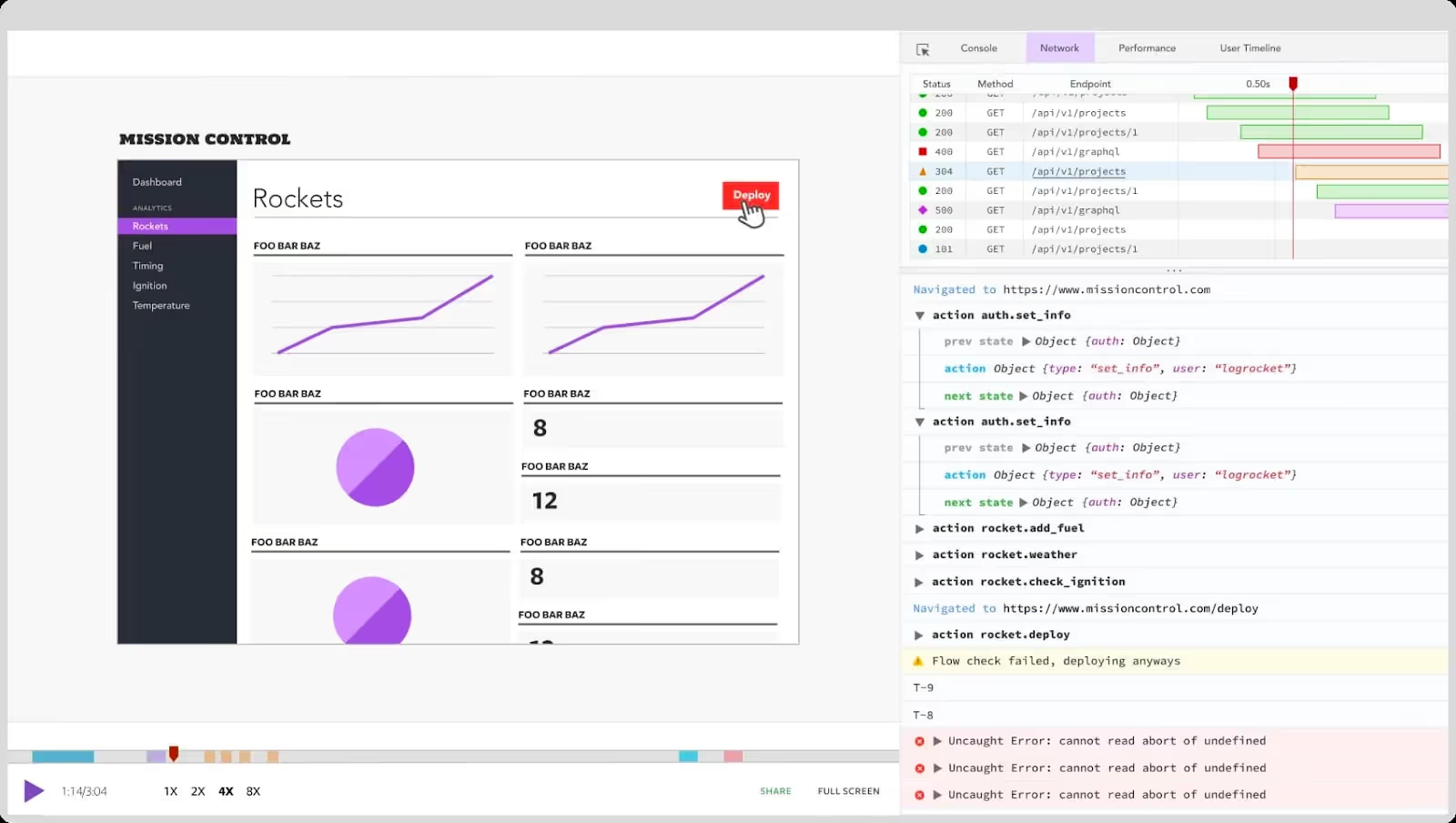
Best for: Teams with people from different departments, like engineers, support staff, product managers, designers, and marketers, who need to keep track of all their problems and figure out how they affect the business.
LogRocket keeps track of website problems and performance data to see how they affect business goals. The platform lets teams know about serious problems with websites and web applications and lets them debug and deploy fixes. Session replay gives a clear picture of the user experience for in-depth analysis.
The platform has a lot of different team functions and specialized analytics to improve the user experience and link business performance to user experience.
All the features of LogRocket :
More Advanced Features:
- The ability to search through sessions to find support tickets
- Tools for looking into problems that users report
- Keeping track of frustration, like rage clicks and dead clicks
- Collecting performance data to analyze its effect on the business
How Prices Work:
- Trial: You can try it out for 14 days.
- Free Plan: 1,000 sessions a month for free forever
- Paid Plans: $69 a month for 10,000 sessions a year
Evaluation: This tool has great website monitoring and user experience features, but it costs more than other tools on the market that do the same thing. Full set of tools for teams from different departments to work together.
Smartlook: User analytics that use both numbers and words

Best for: Product teams that want to see the whole user journey by combining session replays, heatmaps, and crash reports from web and mobile apps
Smartlook helps you understand how users move around your website and what their experience is like by combining quantitative and qualitative analytics. The platform uses session replays, heatmaps, events, funnels, and crash reports to give a full picture of how users interact with websites and mobile apps.
Event tracking keeps track of everything a user does, like clicking buttons and visiting pages. Drop-off analysis shows exactly where users leave the paths and conversion funnels they were supposed to follow.
Smartlook Analytics Suite :
Features for User Experience:
- Analysis of engagement patterns based on heatmaps
- Analytics that work on both mobile and web apps
- Recording sessions with tracking of issues and their solutions
- Mapping out the user's journey across different application touchpoints
Model for Pricing:
- Trial: You can try it for free for 30 days.
- Free Plan: 3,000 sessions a month are included
- Paid Plans: $55 a month for 5,000 sessions a month
Evaluation: This qualitative data analysis software works well, but it costs more than similar tools. Add-ons like DevTools and product analytics raise the overall price.
Sentry: An application performance and error tracking tool for developers
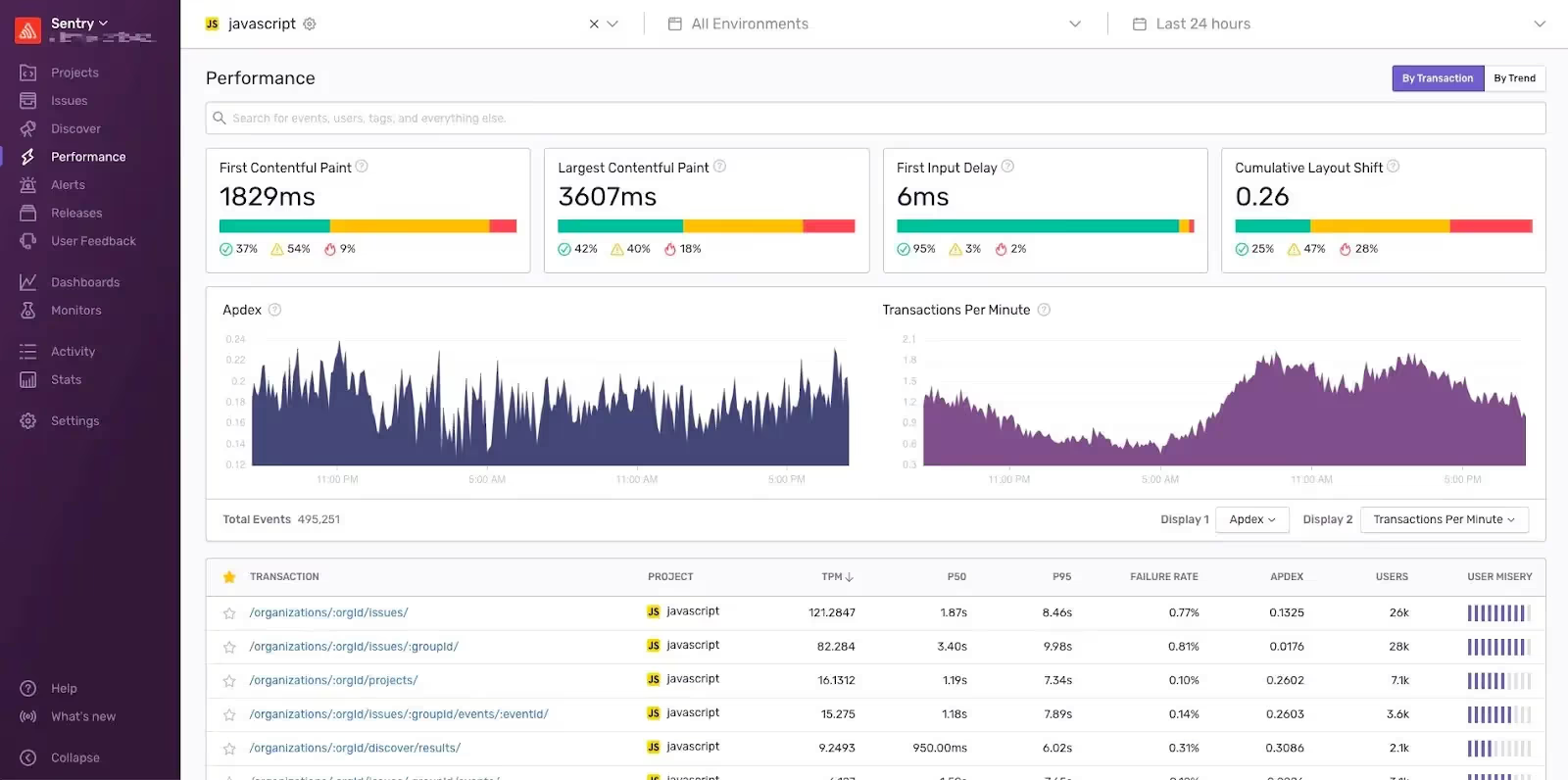
Best for: Development teams that need self-hosted or cloud-based monitoring with full error tracking, performance monitoring, and distributed tracing features
Sentry is an application monitoring tool that puts developers first and focuses on broken code lines, crashes, and failed API calls. The platform makes it easy to find the root cause of a problem quickly by using contextual information like DOM events, console logs, and network calls. End-to-end distributed tracing shows API calls that don't work well and errors on the front end.
Identifying performance issues stops downtime by keeping an eye on web, mobile, and IoT platforms ahead of time.
Tools for Developing Sentry :
Features for Developers:
- The ability to see and analyze issues across projects
- User environment context with trails of breadcrumbs
- Event trail documentation for thorough debugging
- Works on many platforms, like the web, mobile, and IoT devices
How Prices Work:
- Trial: 14-day free trial period
- Free Plan: Limited performance and error tracking
- Paid Plans: Starting at $26/month for a year with advanced analytics
Review: A free foundation with extra features in paid plans. It takes a lot of time to learn how to keep an eye on new people. Higher costs could be a problem for small businesses and new businesses.
FullStory: Smart digital tools for improving the customer experience
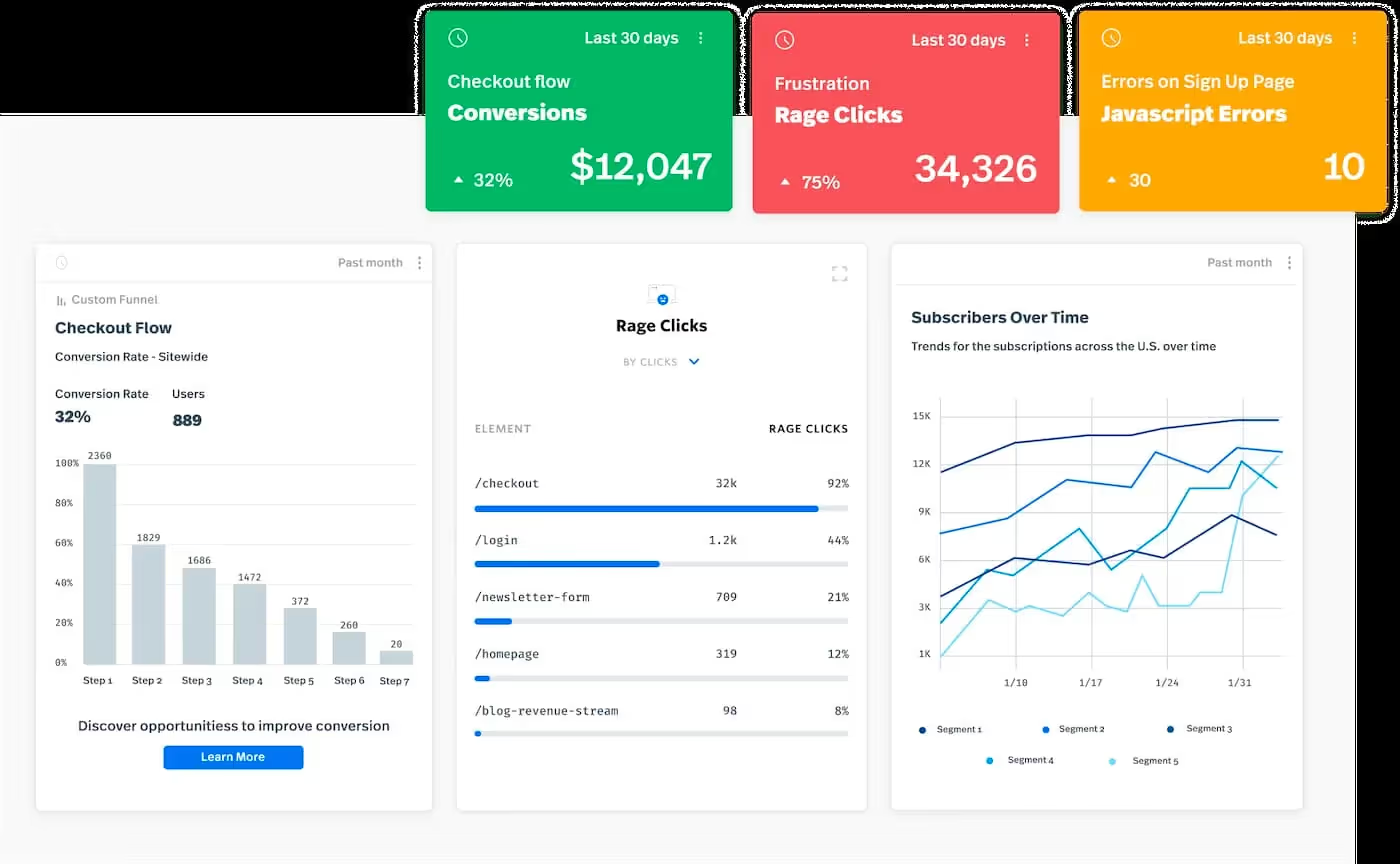
Best for: Product teams that need full-featured digital intelligence systems that can automatically index user activity and target sessions with great accuracy.
FullStory uses digital intelligence systems to make the customer experience better on websites, web apps, and mobile apps. The platform keeps an eye on and tracks what customers do while also finding bugs, areas where things could be better, and ways to improve digital products. Automatic user activity indexing records clicks as pages change.
Powerful query tools let you find sessions that meet certain user and event criteria for in-depth analysis.
Features of FullStory Intelligence
Ability to visualize:
- Full tracking of attention and analysis of visitor flow
- Find click patterns with details about how people interact with pages
- Analyzing the most visited page and how it relates to user behavior
- Network view combined with finding the slowest page
Choices for Prices:
- Trial: You can try it out for 14 days with a maximum of 5,000 sessions.
- Free Plan: 1,000 sessions a month are included
- Paid Plans: Get in touch with the team for a personalized price quote
Evaluation: Basic features are easy to use, but advanced features take longer to learn. There are other tools available at better prices for different stages of a business.
Basic solutions for monitoring uptime and performance
StatusCake: Complete Domain and Uptime Management

Best for: Companies that want to keep an eye on their website's uptime and have global testing coverage and domain management tools
StatusCake keeps an eye on your website's performance, downtime, and domain expiration, and it can send you alerts right away. The platform lets users know about site downtime within 10 seconds of finding it. Global reach means that there are 43 testing sites in 30 different countries around the world.
Dashboards that are easy to use show detailed test information and give you a full picture of how to keep your website healthy.
Coverage of StatusCake Monitoring
Features around the world:
- 43 testing sites in 30 countries for full coverage
- Custom alerts for monitoring system resources
- Domain safety through timely notifications of renewals
- Managing SSL certificates and sending reminders to improve security
How Prices Work:
- Trial: You can try it for free for seven days.
- Free Plan: Limited uptime, page speed, domain, SSL, and server monitoring
- Paid Plans: Monthly payments start at $24.49 and go up from there.
Assessment: This tool is great for keeping an eye on website uptime, but it doesn't let you record user sessions or capture errors. Recommended for businesses that mostly need to keep an eye on their uptime.
Uptimia: Checking transactions and monitoring websites around the world
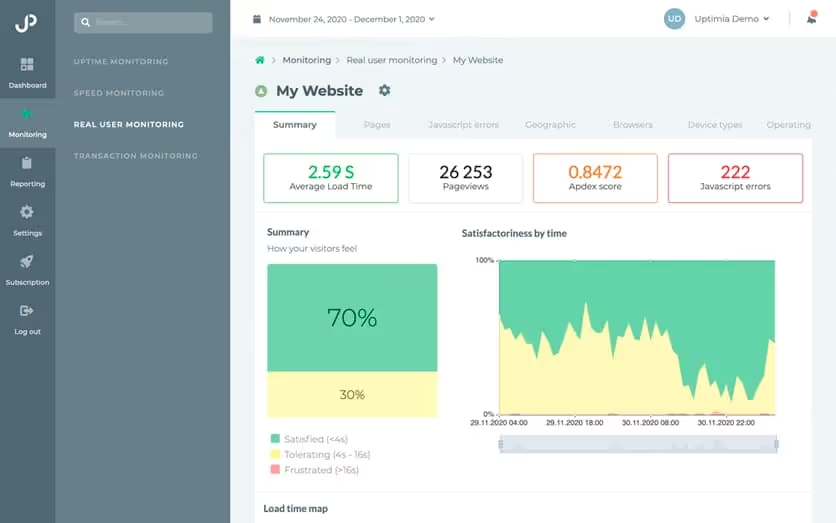
Best for: Companies that need complete monitoring of uptime, speed, transactions, and real user activity from data centers all over the world
Uptimia can monitor websites for uptime, speed, transactions, and real user activity. Free tools for checking if a website is up and running work from many places around the world. The platform has all the features you need to keep your website running at its best.
Transaction monitoring includes login forms, checkout processes, and important user interactions with notifications of failures.
The Uptimia Monitoring Suite
Global Skills:
- A global data center network with 171 locations for full coverage
- Detailed reports on loading speed broken down by location and technology
- Monitoring web transactions and sending automatic failure alerts
- Real user monitoring for real insights into how real users use your site
Model of Pricing:
- Trial: You can try it for free for 30 days.
- Free Plan: You can monitor one website for free.
- Paid Plans: Starting at $9 a month, billed once a year
Assessment: You can track how well your site is doing without any tools for finding and fixing errors. The free plan does not include monitoring real users, transactions, or speed. Good for businesses that want to keep their systems up and running but don't need a full digital experience.
What Should You Think About When Choosing Tools?
Choosing the right website monitoring tools requires careful consideration of many factors that affect the success of the implementation and its long-term value. Think about how easy it is to use, how well it can grow with your business, how well it works with other systems, and whether the price fits your needs. Tool complexity can make it harder to find and fix problems.
How easy it is to use and set up
Pick website monitoring tools that are easy to install and use. Complicated tools make learning harder, which slows down the ability to find and fix problems. It helps new monitoring users to start with free tools and then move on to paid ones.
Simple setup processes cut down on the time it takes to implement something and increase the number of people on the team who can use it, no matter what their level of technical skill is.
Things to think about for growth and scalability
It is very important for monitoring tools to be able to handle more traffic and adapt to sudden spikes. Good tools can handle a lot of traffic without needing the help of a team during busy times.
Check current traffic patterns against growth projections to make sure the tools you choose will meet the needs of your business as it grows.
Checking for Compatibility and Integration
Check how well it can work with other systems, like alerting platforms, ticketing tools, and event management systems. To connect without any problems, you need either easy one-click setups or easy ways to add code.
Strong integration ecosystems make it easy to add new workflows without changing how things are done or how teams work together.
Budget and Value Study
When choosing monitoring tools, make sure they fit your business needs and budget. Also, look at the pricing structures and the features they offer. Many tools can do the same things as more expensive brand-name tools at lower prices.
When looking at the total cost of ownership for monitoring solutions, think about session limits, monitor quotas, and pricing options for growth stages.
What important monitoring features should you put at the top of your list?
Main Features of Monitoring
Put tools that let you monitor real users, track errors, debug code, check performance, and make sure your security is up to date at the top of your list. User identification, session replay, and filtering features add extra value to full website optimization.
These monitoring features directly make websites work better, bring in more high-quality traffic, and improve overall user experience metrics.
Systems for Managing Alerts and Notifications
Good alert systems find a balance between quickly letting people know about problems and lowering noise levels to avoid alert fatigue. Pick tools that let you set up alerts in a way that works best for you, such as by integrating with Slack and email.
Custom alert thresholds let you manage notifications more effectively while making sure that important issues get immediate attention without flooding team communications.
Standards for Data Security and Compliance
When choosing monitoring tools that collect and store website data like login information, performance metrics, and user information, security is very important. Not enough protection makes websites less secure, which can hurt their reputation and make customers less likely to trust them.
Before putting in place monitoring tools that can see sensitive business and customer data, make sure they meet the SOC2, GDPR, and CCPA standards.
Questions People Ask About Website Monitoring Tools
How much do tools for monitoring websites cost?
The price of a website monitoring tool depends a lot on its features, how often it checks the site, and how much data it collects. Basic uptime monitoring tools like Uptime Robot cost about $7 a month, while more advanced ones like Zipy.ai and LogRocket cost between $39 and $69 a month. Many tools, like Zipy.ai, offer free plans for basic monitoring needs.
Depending on how much traffic you get and what features you need, enterprise solutions with advanced features like session replay, error tracking, and AI-powered insights can cost between $100 and $500 per month. When making a budget, think about the total cost, which includes setup time, team training, and the cost of scaling. A lot of vendors let you try their products for free for 7 to 30 days before you have to buy them.
What's the difference between monitoring a website and monitoring its uptime?
Uptime monitoring only checks to see if your website is up and running and responding to requests. It usually does this from several places every 1 to 5 minutes. Website monitoring includes more features, such as tracking performance, analyzing the user experience, finding errors, replaying sessions, and keeping an eye on the conversion funnel.
StatusCake and Pingdom are great for tracking uptime, but they don't give you any information about how users behave. Zipy.ai, LogRocket, and FullStory are examples of all-in-one website monitoring platforms that offer session replay, error tracking, performance metrics, and analysis of the user journey. Choose uptime-only tools if you only need basic availability, or full website monitoring if you want to optimize the whole user experience.
How do tools that watch websites find problems with the user experience?
Session replay technology, heatmap analysis, error tracking, and performance metrics are some of the ways that website monitoring tools find UX problems. These platforms keep track of real user actions like clicks, scrolls, form submissions, and how people navigate around. AI algorithms find rage clicks, dead clicks, and patterns of user frustration that show problems with the user experience.
Advanced tools like Zipy.ai and LogRocket link user actions to things like technical problems, slow page loads, and drops in conversions. Real user monitoring (RUM) records how real users interact with your site on different devices, browsers, and locations. Synthetic monitoring acts out user journeys to find possible problems before real users do.
Do tools for monitoring websites work with SPAs and new frameworks?
Modern website monitoring tools are made just for single-page apps that use React, Vue, Angular, and other JavaScript frameworks. Zipy.ai, LogRocket, and Sentry are examples of tools that offer specialized SDKs that work well with SPAs. These SDKs can track route changes, component interactions, and AJAX requests.
These platforms keep an eye on things like loading dynamic content, client-side errors, API calls, and virtual page views that regular monitoring might not catch. Session replay tools record SPA interactions like modal dialogs, dropdown menus, and dynamic form validation. Most of the best website monitoring tools have installation guides and support for modern development practices that are specific to each framework.
Which tool for monitoring websites is best for e-commerce sites?
Comprehensive monitoring tools that keep an eye on both technical performance and user behavior throughout the purchase process are the most helpful for e-commerce sites. Zipy.ai is great at session replay, error tracking, and conversion analysis, and its prices are competitive. LogRocket and FullStory give you a lot of information about how users move through your site so you can figure out why they leave the checkout process.
For online shopping, make sure to use tools that let you keep an eye on transactions, track the flow of payments, look at cart abandonment rates, and see how real users are performing. Check to see if it works with analytics tools, A/B testing tools, and customer support systems. Consider tools with user identification features to track VIP customers and segment analysis by user value.
.svg)






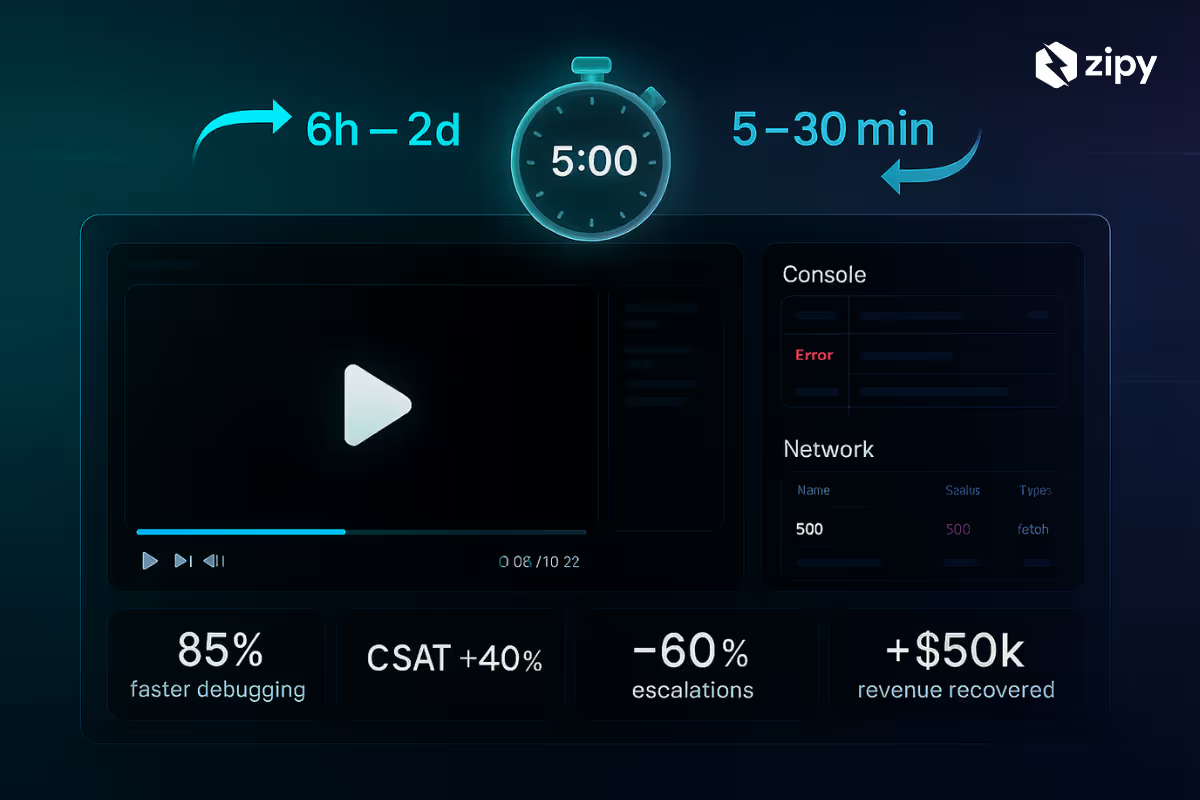
.avif)



.webp)